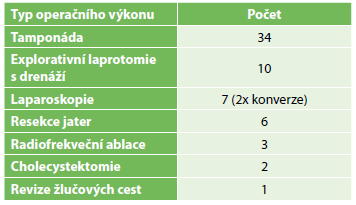Abstract
Introduction: Traumatic liver injury is the most frequent cause of death due to traumatic bleeding in the peritoneal cavity. The progress of pre-hospital emergency medical service, improved surgical techniques, and advanced post-operative care decreased the morbidity from 65% to 10% over the last 40 years. The management is either surgical or non-surgical. Operation is indicated in case of haemodynamic instability and failure of non-surgical treatment. The aim of the paper is to evaluate the aetiology of liver injury, the type of treatment, and therapeutic results in patients hospitalized between 2006 and 2018 at the Trauma Centre of the University Hospital in Pilsen.
Methods: Our retrospective study includes 322 patients. Assessed characteristics: Type of injury (polytraumatic or monotraumatic), cause of trauma, trauma grade according to The American Association for the Surgery of Trauma, type of treatment, complications, mortality and the length of stay.
Results: There were 191 male and 131 female patients included in the study; 18.9% of these were children below the age of 16. Polytraumata represented 53.1%, multiple traumata 35.4% and monotraumata 11.5% of all injuries; 94.7% of patients had a blunt trauma of the liver and the most common reason of injury was traffic accident (57.8%). Conservative management was applied in 66.1% of all patients. The following surgical procedures were performed: liver packing (34 cases), exploration and drainage (10), liver resection (5), laparoscopy (7), radiofrequency ablation (3), cholecystectomy (2), and one case of bile duct revision. Thirty-day mortality was 7.7%. One patient died of bilateral pneumonia...

